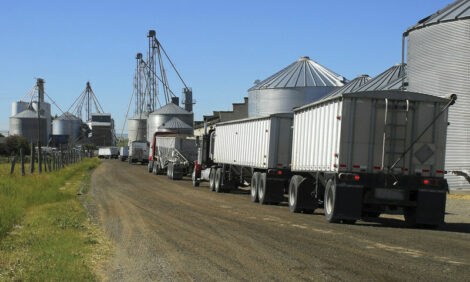



Purdue Study says lifestyle changes have boosted poultry, fish at expense of pork production
WEST LAFAYETTE - Chicken and fish are carving out a larger place on America's dinner plate at the expense of cattle and pigs.
Purdue University researchers studying 30 years of U.S. Department of
Agriculture data found that a combination of demographic, health and
ease-of-preparation factors led to increased consumption of poultry and
fish in the United States. Meanwhile, consumption of beef and pork
either dipped or stagnated.
"We looked at USDA per capita consumption data from 1970 to 1999, and
beef consumption decreased while pork consumption stayed about the
same," said Christiane Schroeter, a Purdue agricultural economics
graduate student. "Poultry had a huge increase in consumption, and
there also was a slight increase in fish consumption. There's
definitely been a change in the overall pattern."
Before the mid-1980s, beef and pork were Nos. 1 and 2 in per capita
consumption among the four meat groups. By the late 1980s, poultry
zoomed past pork in consumer demand and, by the end of the 20th
century, poultry consumption had nearly pulled even with beef. Fish
consumption, while a distant fourth, gradually rose throughout the
30-year study period.
Schroeter and fellow researcher Ken Foster, a Purdue agricultural
economist, tracked meat demand trends from per capita consumption and
consumer price data collected by the USDA's Economic Research Service.
They also factored in data from the U.S. Census Bureau and several
previous studies that examined the affect of health information on meat
consumption.
The Purdue researchers concluded that changes in the American diet and
greater numbers of women in the work force were the primary forces
behind the gains made by poultry and fish. The introduction of
microwavable foods and the addition of poultry and fish on fast-food
restaurant menus also contributed, Foster said.
"Chicken and fish have made some pretty strong inroads" in per capita
consumption, Foster said. "Perhaps some of that increase is in response
to issues of health and changing family dynamics.
"We surmise from this data that with more women in the work force as
opposed to 30 or 40 years ago, there is no adult at home with the kids.
When the children come home from school the microwave is an appliance
that they are allowed to use to prepare themselves some food. As it
turns out, either because of the form of the product or because the
marketers of fish and poultry have been more successful in making their
products microwavable, those two products tend to benefit, relative to
pork and beef."
The Purdue study indicated that journal articles containing negative
information on cholesterol appear to have less influence on consumer
attitudes regarding meat consumption than does convenience in meal
preparation.
Total U.S. per capita meat consumption grew 9.3 percent from 1970 to
1999, Schroeter said. In that time span, poultry consumption nearly
doubled, to about 67 pounds per person. Consumer demand for fish
increased a third, to about 15 pounds per person.
Per capita beef consumption fell from about 95 pounds in 1976 to just
under 70 pounds in 1999. Pork consumption dropped from just over 60
pounds per person in 1971 to between 50 pounds and 55 pounds per capita
from 1982 to 1999.
The demand for more chicken and fish and less beef and pork is
reflected in restaurant menus, Foster said. While beef remains a common
choice, Americans are increasingly choosing what they believe are
leaner, healthier options, he said.
"If you think about the menus of fast-food restaurants, years ago it
was hamburgers at the fast-food joint," Foster said. "Now it's a choice
between a hamburger, a fish sandwich, a chicken salad, a chicken
sandwich, and those sorts of things. So while a lot of ground beef is
consumed through fast food or eating away from home, there have been
increases in the consumption of poultry and fish."
And pork?
"You just don't see much pork on those menus," Foster said. "If we were
going to say anything about pork, it is that the industry needs more
products and more exposure in the menus of restaurants and
away-from-home consumption opportunities."
Both researchers said the study has broad implications - and
opportunities - for the agriculture industry.
"Cultural diversity is increasing and, with it, shifts in demand,"
Schroeter said. "The food industry needs to find a way to diversify its
production towards more convenient products, because consumers are
looking for products that are easy to prepare."
As it rushes to satisfy consumer demands for nutritious, convenient
products, the agriculture sector cannot forget food safety issues,
Foster said.
"When we think about diversification strategies for food products, more
and more we're talking about aspects that may require traceability of
compliance all the way back to the farm level," he said. "We might be
talking about antibiotic use. We might be talking about animal welfare.
We could be talking about environmental compliance - any number of
things that might require some integration of the system for compliance
for certifying or differentiating products.
"Those things don't necessarily key into the convenience side of the
equation, but they do provide niche opportunities for individuals who
can do those things at a cost-effective level."
A summary of Schroeter's and Foster's study, "The Impact of Health
Information and Women in the Work Force on Aggregate Meat Demand,"
appears in the August 2004 issue of the Purdue Agricultural Economics
Report. The publication is available online at
http://www.agecon.purdue.edu/extension/pubs/paer/.
Source: Purdue News Service - 27th September 2004









